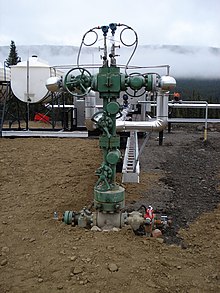A wellhead is the component at the surface of an oil or gas well that provides the structural and pressure-containing interface for the drilling and production equipment.


The primary purpose of a wellhead is to provide the suspension point and pressure seals for the casing strings that run from the bottom of the hole sections to the surface pressure control equipment.[1]
While drilling the oil well, surface pressure control is provided by a blowout preventer (BOP). If the pressure is not contained during drilling operations by the column of drilling fluid, casings, wellhead, and BOP, a well blowout could occur.
When the well has been drilled, it is completed to provide an interface with the reservoir rock and a tubular conduit for the well fluids. The surface pressure control is provided by a Christmas tree, which is installed on top of the wellhead, with isolation valves and choke equipment to control the flow of well fluids during production.
Wellheads are typically welded onto the first string of casing, which has been cemented in place during drilling operations, to form an integral structure of the well. In exploration wells that are later abandoned, the wellhead may be recovered for refurbishment and re-use.
Offshore, where a wellhead is located on the production platform it is called a surface wellhead, and if located beneath the water then it is referred to as a subsea wellhead or mudline wellhead.[2][3][4][5]
- ^ Schlumberger Limited, oil well
- ^ Croft systems, The Difference Between a Wellhead & Christmas Tree, August 29, 2014, by Meisa G
- ^ New Wellhead Design Speeds Up Operations, Schlumberger company, October 12, 2016
- ^ EPA, Wellhead Protection Program
- ^ SFX: Standardized Fatigue-Resistant Wellhead System Solution